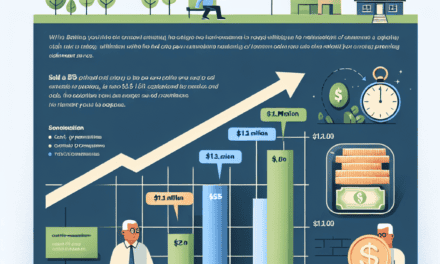“Seize the Dip: Opportunity Knocks with Microsoft’s Market Shift!”
Introduction
Microsoft’s stock has recently experienced a significant decline, capturing the attention of investors and market analysts alike. This downturn raises critical questions about the underlying factors contributing to the drop and whether it presents a strategic opportunity for investment. As one of the world’s leading technology companies, Microsoft’s financial performance and market position are closely scrutinized, making any fluctuation in its stock price a topic of considerable interest. In this analysis, we explore the reasons behind the stock’s plummet, assess the company’s long-term prospects, and evaluate whether the current dip offers a favorable entry point for investors looking to capitalize on potential future gains.
Analyzing Microsoft’s Recent Stock Decline: Causes and Implications
Microsoft’s recent stock decline has captured the attention of investors and analysts alike, prompting a closer examination of the underlying causes and potential implications for the future. The technology giant, known for its robust financial performance and innovative product offerings, has experienced a notable dip in its stock value, raising questions about the factors contributing to this downturn and whether it presents a strategic investment opportunity.
To begin with, one of the primary factors influencing Microsoft’s stock decline is the broader economic environment. The global economy has been grappling with a myriad of challenges, including inflationary pressures, supply chain disruptions, and geopolitical tensions. These macroeconomic factors have created a ripple effect across various industries, and the technology sector is no exception. As a result, investor sentiment has been cautious, leading to a sell-off in tech stocks, including Microsoft.
Moreover, Microsoft’s recent earnings report revealed some areas of concern that have further contributed to the stock’s decline. While the company reported strong revenue growth in its cloud computing division, Azure, other segments such as personal computing and productivity software showed signs of slowing growth. This deceleration has raised concerns about Microsoft’s ability to sustain its impressive growth trajectory, especially in the face of increasing competition from other tech giants like Amazon and Google.
In addition to these internal challenges, regulatory scrutiny has also played a role in Microsoft’s stock performance. Governments around the world are intensifying their focus on big tech companies, scrutinizing their business practices and market dominance. Microsoft, despite its relatively favorable reputation compared to some of its peers, is not immune to this scrutiny. Potential regulatory actions could impact its operations and profitability, adding another layer of uncertainty for investors.
Despite these challenges, it is essential to consider the long-term prospects of Microsoft. The company has a strong track record of adapting to changing market dynamics and leveraging its diverse portfolio to drive growth. Its strategic investments in artificial intelligence, cloud computing, and other emerging technologies position it well for future success. Furthermore, Microsoft’s commitment to sustainability and corporate responsibility enhances its appeal to socially conscious investors.
Given these considerations, the question arises: is now the time to invest in Microsoft? For value-oriented investors, the recent stock decline may present an attractive entry point. The company’s fundamentals remain strong, and its ability to generate consistent cash flow provides a solid foundation for future growth. Additionally, Microsoft’s dividend policy offers a steady income stream, which can be appealing in volatile market conditions.
However, potential investors should also weigh the risks associated with the current economic climate and regulatory landscape. It is crucial to conduct thorough research and consider one’s risk tolerance before making investment decisions. Diversification remains a key strategy to mitigate potential losses and capitalize on opportunities across different sectors.
In conclusion, while Microsoft’s recent stock decline may raise concerns, it also presents a potential opportunity for investors willing to take a long-term view. By carefully analyzing the causes and implications of this downturn, investors can make informed decisions that align with their financial goals and risk appetite. As the market continues to evolve, staying informed and adaptable will be essential for navigating the complexities of investing in technology stocks like Microsoft.
Historical Performance: How Microsoft Has Rebounded from Past Dips
Microsoft Corporation, a titan in the technology industry, has long been a staple in the portfolios of investors seeking stability and growth. Over the years, the company has demonstrated a remarkable ability to rebound from market downturns, a testament to its robust business model and strategic foresight. Understanding Microsoft’s historical performance during periods of stock price declines can provide valuable insights for investors contemplating whether now might be an opportune moment to invest, following the recent plummet in its stock value.
To begin with, it is essential to consider Microsoft’s resilience during the dot-com bubble burst in the early 2000s. Like many technology companies, Microsoft experienced a significant drop in its stock price as the bubble burst. However, the company managed to navigate this challenging period by focusing on its core strengths and diversifying its product offerings. By investing in cloud computing and enterprise solutions, Microsoft laid the groundwork for future growth, which eventually led to a strong recovery in its stock price. This strategic pivot not only helped Microsoft regain its footing but also positioned it as a leader in the burgeoning cloud services market.
Transitioning to the 2008 financial crisis, Microsoft once again faced a turbulent market environment. The global economic downturn led to a sharp decline in consumer spending and business investments, impacting technology companies worldwide. Despite these challenges, Microsoft demonstrated resilience by continuing to innovate and expand its product portfolio. The launch of Windows 7 in 2009, coupled with the growth of its Office suite and server products, helped the company weather the storm. As the economy gradually recovered, Microsoft’s stock price rebounded, reflecting the company’s ability to adapt and thrive even in adverse conditions.
Moreover, the transition to a mobile-first, cloud-first world under the leadership of CEO Satya Nadella marked another pivotal moment in Microsoft’s history. When Nadella took the helm in 2014, Microsoft was facing intense competition from rivals like Apple and Google. The company’s stock had been relatively stagnant for years, prompting concerns about its long-term growth prospects. However, Nadella’s strategic focus on cloud computing, particularly through the expansion of Azure, revitalized Microsoft’s growth trajectory. This shift not only propelled the company’s stock to new heights but also underscored its capacity for reinvention and adaptation in a rapidly evolving technological landscape.
In light of these historical precedents, the recent decline in Microsoft’s stock price may present a compelling opportunity for investors. While market volatility and economic uncertainties can be daunting, Microsoft’s track record of rebounding from past dips suggests that the company possesses the resilience and strategic acumen necessary to overcome current challenges. Furthermore, Microsoft’s continued investments in artificial intelligence, cloud computing, and other emerging technologies position it well for future growth.
In conclusion, while no investment is without risk, Microsoft’s historical performance during periods of stock price declines offers a reassuring narrative for potential investors. The company’s ability to adapt, innovate, and capitalize on new opportunities has consistently driven its recovery and growth. As such, those considering an investment in Microsoft amidst its recent stock plummet may find solace in the company’s proven resilience and strategic foresight, which have historically paved the way for robust rebounds and long-term success.
Expert Opinions: What Analysts Are Saying About Microsoft’s Future
In recent weeks, Microsoft has experienced a significant decline in its stock value, prompting investors and analysts alike to scrutinize the tech giant’s future prospects. This downturn has raised questions about whether now might be an opportune moment to invest in the company. To better understand the situation, it is essential to consider the perspectives of financial experts and market analysts who have been closely monitoring Microsoft’s trajectory.
Firstly, it is important to acknowledge the factors contributing to the recent drop in Microsoft’s stock price. Analysts point to a combination of macroeconomic challenges, such as rising interest rates and global economic uncertainties, which have affected the broader technology sector. Additionally, Microsoft’s latest earnings report, while still robust, fell short of some investors’ expectations, leading to a reevaluation of the company’s growth potential. Despite these challenges, many experts maintain a cautiously optimistic outlook on Microsoft’s long-term prospects.
One of the key reasons for this optimism is Microsoft’s strong position in the cloud computing market. The company’s Azure platform continues to be a major growth driver, with significant year-over-year revenue increases. Analysts highlight that the demand for cloud services is expected to remain strong as businesses increasingly rely on digital infrastructure. This trend positions Microsoft well to capitalize on future opportunities, even amid short-term market fluctuations.
Moreover, Microsoft’s diverse product portfolio and strategic investments in artificial intelligence and other emerging technologies are seen as vital components of its growth strategy. The company’s commitment to innovation and its ability to adapt to changing market dynamics are frequently cited by analysts as reasons to remain confident in its future performance. Furthermore, Microsoft’s strong balance sheet and consistent cash flow provide a solid foundation for continued investment in research and development, which is crucial for maintaining its competitive edge.
In addition to these factors, Microsoft’s leadership under CEO Satya Nadella is often praised for its strategic vision and execution. Nadella’s focus on transforming Microsoft into a cloud-first, mobile-first company has been instrumental in its recent successes. Analysts believe that his leadership will continue to guide the company through current challenges and position it for sustained growth in the coming years.
However, it is also important to consider the potential risks associated with investing in Microsoft at this time. The technology sector is inherently volatile, and external factors such as regulatory changes and geopolitical tensions could impact Microsoft’s operations and financial performance. Additionally, increased competition from other tech giants in the cloud computing space could pose challenges to Microsoft’s market share.
In conclusion, while Microsoft’s recent stock decline may cause concern for some investors, many analysts remain optimistic about the company’s long-term prospects. The combination of a strong position in the cloud market, a diverse product portfolio, and strategic leadership are seen as key factors that could drive future growth. Nevertheless, potential investors should carefully weigh the risks and consider their own financial goals and risk tolerance before making any investment decisions. As always, consulting with a financial advisor can provide valuable insights tailored to individual circumstances. Ultimately, whether now is the right time to invest in Microsoft will depend on one’s confidence in the company’s ability to navigate current challenges and capitalize on future opportunities.
Risk vs. Reward: Evaluating the Investment Potential in Microsoft

In the ever-evolving landscape of technology stocks, Microsoft has long been a stalwart, consistently delivering robust financial performance and innovation. However, recent market fluctuations have seen Microsoft’s stock take a significant hit, prompting investors to reassess their positions. This downturn raises a critical question: is now the opportune moment to invest in Microsoft, or does the current volatility signal a need for caution? To answer this, one must weigh the potential risks against the rewards, considering both the company’s fundamentals and the broader market conditions.
Firstly, it is essential to understand the factors contributing to the recent decline in Microsoft’s stock price. Market analysts point to a combination of macroeconomic pressures, such as rising interest rates and geopolitical tensions, which have collectively dampened investor sentiment across the tech sector. Additionally, Microsoft’s latest earnings report, while still strong, fell short of some analysts’ expectations, further exacerbating the stock’s downward trajectory. Despite these challenges, Microsoft remains a dominant player in the technology industry, with a diverse portfolio that includes cloud computing, software, and hardware solutions. This diversification is a critical factor that could mitigate risks and provide a buffer against market volatility.
Moreover, Microsoft’s Azure cloud platform continues to be a significant growth driver, capturing an increasing share of the cloud market. As businesses worldwide accelerate their digital transformation efforts, the demand for cloud services is expected to rise, potentially boosting Microsoft’s revenue streams. Furthermore, Microsoft’s strategic investments in artificial intelligence and machine learning position the company at the forefront of technological innovation, offering long-term growth prospects. These factors suggest that, despite current setbacks, Microsoft possesses the resilience and capability to rebound and deliver value to its shareholders.
On the other hand, potential investors must also consider the inherent risks associated with investing in a volatile market environment. The global economic landscape remains uncertain, with inflationary pressures and supply chain disruptions posing ongoing challenges. These factors could impact Microsoft’s operational efficiency and profit margins, leading to further stock price fluctuations. Additionally, the competitive nature of the technology sector means that Microsoft must continuously innovate to maintain its market position, a task that requires substantial investment and carries its own set of risks.
In light of these considerations, prospective investors should adopt a balanced approach when evaluating Microsoft’s investment potential. Conducting thorough research and analysis is crucial, taking into account both the company’s financial health and the external factors influencing its performance. Diversification within one’s investment portfolio can also help mitigate risks, ensuring that exposure to any single stock, including Microsoft, is appropriately managed.
Ultimately, the decision to invest in Microsoft at this juncture hinges on an individual’s risk tolerance and investment strategy. For those with a long-term perspective and a willingness to weather short-term volatility, Microsoft’s strong fundamentals and growth prospects may present an attractive opportunity. Conversely, more risk-averse investors might prefer to wait for greater market stability before committing capital. In conclusion, while the current dip in Microsoft’s stock price may be unsettling, it also presents a potential entry point for discerning investors who are prepared to navigate the complexities of the market.
Comparing Microsoft with Competitors: Is It a Better Buy Now?
In the ever-evolving landscape of technology stocks, Microsoft has long been a stalwart, consistently delivering robust financial performance and maintaining a strong market presence. However, recent fluctuations have seen Microsoft’s stock take a significant hit, prompting investors to reassess its position relative to its competitors. As the stock plummets, the question arises: is now the opportune moment to invest in Microsoft, or do its competitors present a more compelling case?
To begin with, it is essential to understand the factors contributing to Microsoft’s recent stock decline. Market analysts point to a combination of macroeconomic pressures, such as rising interest rates and global supply chain disruptions, which have affected the broader tech sector. Additionally, Microsoft’s latest earnings report, while still strong, fell short of some investor expectations, leading to a sell-off. Despite these challenges, Microsoft remains a formidable player in the tech industry, with a diverse portfolio that includes cloud computing, software, and hardware.
When comparing Microsoft to its competitors, one must consider the company’s position in the cloud computing market, where it competes directly with Amazon Web Services (AWS) and Google Cloud. Microsoft’s Azure platform has been a significant growth driver, consistently capturing market share and expanding its service offerings. While AWS remains the leader in cloud services, Azure’s growth trajectory suggests that Microsoft is well-positioned to capitalize on the increasing demand for cloud solutions. This potential for growth could make Microsoft an attractive investment, especially if the stock price continues to be undervalued.
Moreover, Microsoft’s commitment to innovation and strategic acquisitions further strengthens its competitive edge. The company’s acquisition of LinkedIn and its investments in artificial intelligence and gaming, particularly through its Xbox division, demonstrate a forward-thinking approach that could yield substantial returns in the long term. In contrast, competitors like Apple and Google have their strengths, with Apple focusing on hardware and ecosystem integration and Google leveraging its dominance in search and advertising. However, Microsoft’s diversified approach may offer a more balanced risk-reward profile for investors.
Furthermore, Microsoft’s financial health remains robust, with a strong balance sheet and consistent cash flow generation. This financial stability allows the company to weather economic downturns and invest in future growth opportunities. In comparison, some competitors may not have the same level of financial resilience, which could impact their ability to navigate challenging market conditions.
Nevertheless, potential investors must also consider the risks associated with investing in Microsoft at this juncture. The tech industry is inherently volatile, and external factors such as regulatory scrutiny and geopolitical tensions could pose challenges. Additionally, the competitive landscape is fierce, with companies like Amazon and Google continuously innovating and expanding their offerings.
In conclusion, while Microsoft’s recent stock decline may raise concerns, it also presents a potential buying opportunity for investors who believe in the company’s long-term prospects. By comparing Microsoft with its competitors, it becomes evident that the company possesses unique strengths and a diversified business model that could drive future growth. However, as with any investment decision, it is crucial for investors to conduct thorough research and consider their risk tolerance before making a move. Ultimately, whether Microsoft is a better buy now depends on one’s confidence in the company’s ability to navigate current challenges and capitalize on emerging opportunities.
Long-term Outlook: Microsoft’s Growth Prospects in Emerging Markets
Microsoft’s recent stock decline has sparked considerable debate among investors, with many questioning whether this presents a strategic opportunity for long-term investment. While the immediate market reaction may seem disconcerting, a closer examination of Microsoft’s growth prospects in emerging markets reveals a more nuanced picture. These regions, characterized by rapid technological adoption and expanding digital infrastructure, offer fertile ground for Microsoft’s continued expansion and innovation.
To begin with, emerging markets are experiencing a surge in demand for cloud computing services, a sector where Microsoft has established a formidable presence through its Azure platform. As businesses in these regions increasingly migrate to the cloud to enhance operational efficiency and scalability, Microsoft stands to benefit significantly. The company’s strategic investments in data centers across Asia, Africa, and Latin America underscore its commitment to capturing this burgeoning market. By localizing its infrastructure, Microsoft not only improves service delivery but also aligns itself with regional regulatory requirements, thereby enhancing its competitive edge.
Moreover, Microsoft’s focus on artificial intelligence (AI) and machine learning (ML) further bolsters its growth prospects in emerging markets. These technologies are becoming integral to various industries, from agriculture to healthcare, offering solutions that address local challenges. For instance, AI-driven tools can optimize supply chains, improve crop yields, and enhance patient care, thereby driving demand for Microsoft’s innovative solutions. By tailoring its AI and ML offerings to meet the specific needs of these markets, Microsoft can foster deeper customer engagement and loyalty.
In addition to technological advancements, Microsoft’s commitment to education and skill development in emerging markets is noteworthy. Through initiatives like the Microsoft Global Skills Initiative, the company aims to equip millions with digital skills, thereby creating a skilled workforce that can leverage Microsoft’s technologies. This not only expands the company’s user base but also contributes to the socio-economic development of these regions. As more individuals and businesses become proficient in using Microsoft’s products, the company’s ecosystem becomes more entrenched, leading to sustained growth.
Furthermore, Microsoft’s strategic partnerships with local governments and enterprises play a crucial role in its expansion strategy. By collaborating with key stakeholders, Microsoft can navigate complex regulatory landscapes and gain insights into local market dynamics. These partnerships often result in joint ventures and co-innovation projects that drive technological adoption and create new revenue streams. As a result, Microsoft can position itself as a trusted partner in the digital transformation journeys of emerging markets.
While the potential for growth in these regions is substantial, it is essential to acknowledge the challenges that Microsoft may face. Economic volatility, political instability, and infrastructural limitations can pose significant hurdles. However, Microsoft’s robust risk management strategies and adaptive business model equip it to navigate these uncertainties effectively. By leveraging its global experience and local expertise, Microsoft can mitigate risks and capitalize on opportunities.
In conclusion, while Microsoft’s recent stock performance may raise concerns, its long-term growth prospects in emerging markets present a compelling case for investment. The company’s strategic focus on cloud computing, AI, education, and partnerships positions it well to tap into the immense potential of these regions. For investors with a long-term perspective, the current dip in Microsoft’s stock price could indeed represent a timely opportunity to invest in a company poised for sustained growth in the dynamic landscape of emerging markets.
Diversification Strategy: How Microsoft Fits into a Balanced Portfolio
In the ever-evolving landscape of global finance, the recent downturn in Microsoft stock has captured the attention of investors worldwide. As the tech giant experiences a significant dip in its market value, many are left pondering whether this presents a unique opportunity to incorporate Microsoft into a diversified investment portfolio. Understanding how Microsoft fits into a balanced portfolio requires a nuanced examination of both the company’s intrinsic value and the broader market dynamics.
To begin with, diversification is a fundamental strategy in investment, aimed at minimizing risk by spreading investments across various financial instruments, industries, and other categories. By doing so, investors can potentially offset losses in one area with gains in another. Microsoft, with its vast array of products and services, offers a unique proposition for diversification. The company’s operations span across software, cloud computing, gaming, and artificial intelligence, among others. This diversification within Microsoft itself can provide a buffer against sector-specific downturns, making it an attractive option for investors seeking stability.
Moreover, the recent decline in Microsoft’s stock price may be attributed to a confluence of factors, including market volatility, geopolitical tensions, and shifts in consumer demand. However, it is crucial to recognize that such fluctuations are not uncommon in the stock market. Historically, Microsoft has demonstrated resilience and an ability to adapt to changing market conditions. Its strong balance sheet, consistent revenue growth, and strategic investments in emerging technologies position it well for long-term success. Consequently, the current dip in stock price might be perceived as a temporary setback rather than a reflection of the company’s fundamental value.
Incorporating Microsoft into a balanced portfolio also aligns with the principle of investing in blue-chip stocks. These are well-established companies with a history of reliable performance, often characterized by their ability to weather economic downturns. Microsoft’s reputation as a blue-chip stock is bolstered by its robust financial health and its leadership position in the technology sector. For investors seeking to balance risk and reward, adding Microsoft to their portfolio could provide a measure of security and potential for growth.
Furthermore, the technology sector continues to be a driving force in the global economy, with digital transformation initiatives gaining momentum across industries. Microsoft’s strategic focus on cloud computing through its Azure platform, as well as its investments in artificial intelligence and machine learning, underscore its commitment to innovation. These areas are poised for significant growth, offering investors exposure to cutting-edge technologies that are reshaping the future.
Nevertheless, it is essential for investors to conduct thorough research and consider their individual risk tolerance and investment goals before making any decisions. While the current dip in Microsoft’s stock may present a buying opportunity, it is important to assess how it aligns with one’s overall investment strategy. Diversification should not only involve spreading investments across different sectors but also ensuring that each component of the portfolio contributes to the desired balance of risk and return.
In conclusion, the recent decline in Microsoft stock presents a compelling case for its inclusion in a diversified investment portfolio. By leveraging Microsoft’s inherent strengths and its strategic positioning in the technology sector, investors can potentially enhance their portfolio’s resilience and growth prospects. As with any investment decision, careful consideration and a long-term perspective are paramount to achieving financial success.
Q&A
1. **What caused Microsoft’s stock to plummet?**
Microsoft’s stock plummeted due to a combination of factors such as disappointing earnings reports, market volatility, or broader economic concerns impacting tech stocks.
2. **How has Microsoft’s financial performance been recently?**
Microsoft’s recent financial performance showed weaker-than-expected revenue growth, particularly in key segments like cloud computing or software sales.
3. **What are analysts saying about Microsoft’s future prospects?**
Analysts have mixed opinions; some remain optimistic about Microsoft’s long-term growth potential due to its strong market position, while others are cautious due to current economic uncertainties.
4. **Is Microsoft’s stock considered undervalued right now?**
Some investors believe Microsoft’s stock is undervalued given its strong fundamentals and potential for recovery, while others think it may still be overpriced relative to current market conditions.
5. **What are the risks of investing in Microsoft now?**
Risks include potential further declines in stock price, ongoing economic challenges, and increased competition in key business areas like cloud services.
6. **What are the potential benefits of investing in Microsoft now?**
Potential benefits include buying at a lower price point, Microsoft’s strong brand and market position, and potential for long-term growth as the tech sector stabilizes.
7. **What should investors consider before buying Microsoft stock?**
Investors should consider their risk tolerance, the current economic environment, Microsoft’s financial health, and their investment time horizon before deciding to invest.
Conclusion
Microsoft’s stock plummeting may present a potential buying opportunity for investors, but it requires careful consideration of several factors. Investors should assess the reasons behind the decline, such as market conditions, company performance, and broader economic factors. It’s crucial to evaluate Microsoft’s long-term growth prospects, competitive position, and financial health. Additionally, considering the overall market sentiment and potential recovery scenarios is important. Ultimately, whether now is the right time to invest depends on individual risk tolerance, investment goals, and a thorough analysis of Microsoft’s future potential.





